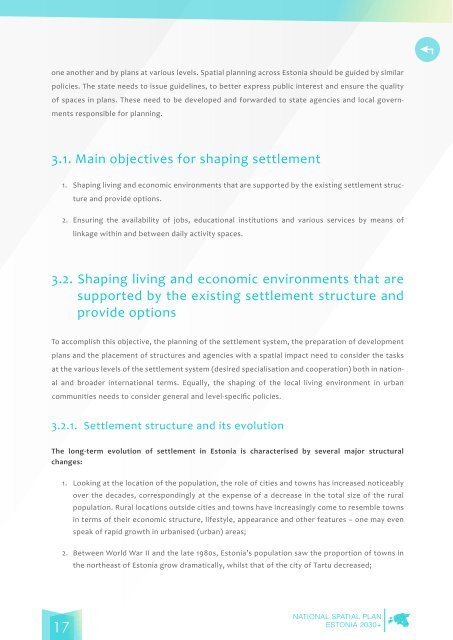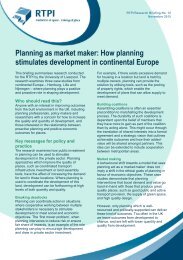3 Balanced and sustainable developm<strong>en</strong>tof settlem<strong>en</strong>tSettlem<strong>en</strong>t is the spatial form of a society; to a large ext<strong>en</strong>t, the living <strong>en</strong>vironm<strong>en</strong>t of people, theeconomic <strong>en</strong>vironm<strong>en</strong>t of the nation and the competitiv<strong>en</strong>ess of its regions dep<strong>en</strong>d on its nature. Ahigh-quality living <strong>en</strong>vironm<strong>en</strong>t means a wider range of options in terms of places to live, jobs andservices as well as a clean natural <strong>en</strong>vironm<strong>en</strong>t, a well-constructed <strong>en</strong>vironm<strong>en</strong>t and sustainabledevelopm<strong>en</strong>t.In striving to str<strong>en</strong>gth<strong>en</strong> Estonia’s international competitiv<strong>en</strong>ess and, at the same time, preservesettlem<strong>en</strong>t across the territory of the <strong>en</strong>tire nation, the Estonian state is steering the developm<strong>en</strong>t ofsettlem<strong>en</strong>t with plans, adhering to the policies of balance and polyc<strong>en</strong>tric developm<strong>en</strong>t. This considersthe changing needs of its economy and resid<strong>en</strong>ts.Ranging from large cities to individual farms in the periphery, the variety of living and economic<strong>en</strong>vironm<strong>en</strong>ts in Estonia is great whilst its quality, in parts, leaves something to be desired. Whereasin cities and towns public space at good levels sometimes cannot be provided, in the periphery theavailability of services and jobs has deteriorated and the economic <strong>en</strong>vironm<strong>en</strong>t does not favour mostindustries because of a dearth of both labour and local consumers.Due to the low-d<strong>en</strong>sity settlem<strong>en</strong>t and predominantly small urban communities in Estonia, improvingthe living and economic <strong>en</strong>vironm<strong>en</strong>ts is closely tied to improving connections betwe<strong>en</strong> the urbancommunities. In this day and age, places to live, jobs, education, services and holidays are giv<strong>en</strong> a newquality by modern information technology and innovativ<strong>en</strong>ess, which impact on and change the needto move and increase the diversity of options. The availability of up-to-date data communicationsnetworks Estonia-wide is one of the prerequisites for balanced spatial developm<strong>en</strong>t. All this, however,is more likely to supplem<strong>en</strong>t rather than supersede the need for people to actually move. Byreasonably <strong>en</strong>couraging daily and seasonal mobility, the low d<strong>en</strong>sity of settlem<strong>en</strong>t and the smallnessof urban communities may be comp<strong>en</strong>sated for in part. On the one hand, this increases the economiccompetitiv<strong>en</strong>ess of urban communities; on the other, it improves access to services (various e-services)and jobs (remote work) for people. The completion of a high-speed Internet network, aided bythe EstWIN project, will see the construction of approximately 6000 kilometres of networks and thecompletion of connection points 3 . The construction of broadband infrastructure will employ primarilythe corridors of some other infrastructure (highways).High-quality living and economic <strong>en</strong>vironm<strong>en</strong>ts have to be provided in both cities and towns and ruralareas. To this <strong>en</strong>d, a lot can be done by coordinating national and regional developm<strong>en</strong>t plans with3 Developm<strong>en</strong>t vision for the next g<strong>en</strong>eration of Estonia’s broadband network (Eesti Lairiba Ar<strong>en</strong>duse SA, 2009)16
one another and by plans at various levels. Spatial planning across Estonia should be guided by similarpolicies. The state needs to issue guidelines, to better express public interest and <strong>en</strong>sure the qualityof spaces in plans. These need to be developed and forwarded to state ag<strong>en</strong>cies and local governm<strong>en</strong>tsresponsible for planning.3.1. Main objectives for shaping settlem<strong>en</strong>t1. Shaping living and economic <strong>en</strong>vironm<strong>en</strong>ts that are supported by the existing settlem<strong>en</strong>t structureand provide options.2. Ensuring the availability of jobs, educational institutions and various services by means oflinkage within and betwe<strong>en</strong> daily activity spaces.3.2. Shaping living and economic <strong>en</strong>vironm<strong>en</strong>ts that aresupported by the existing settlem<strong>en</strong>t structure andprovide optionsTo accomplish this objective, the planning of the settlem<strong>en</strong>t system, the preparation of developm<strong>en</strong>tplans and the placem<strong>en</strong>t of structures and ag<strong>en</strong>cies with a spatial impact need to consider the tasksat the various levels of the settlem<strong>en</strong>t system (desired specialisation and cooperation) both in nationaland broader international terms. Equally, the shaping of the local living <strong>en</strong>vironm<strong>en</strong>t in urbancommunities needs to consider g<strong>en</strong>eral and level-specific policies.3.2.1. Settlem<strong>en</strong>t structure and its evolutionThe long-term evolution of settlem<strong>en</strong>t in Estonia is characterised by several major structuralchanges:1. Looking at the location of the population, the role of cities and towns has increased noticeablyover the decades, correspondingly at the exp<strong>en</strong>se of a decrease in the total size of the ruralpopulation. Rural locations outside cities and towns have increasingly come to resemble townsin terms of their economic structure, lifestyle, appearance and other features – one may ev<strong>en</strong>speak of rapid growth in urbanised (urban) areas;2. Betwe<strong>en</strong> World War II and the late 1980s, Estonia’s population saw the proportion of towns inthe northeast of Estonia grow dramatically, whilst that of the city of Tartu decreased;17




